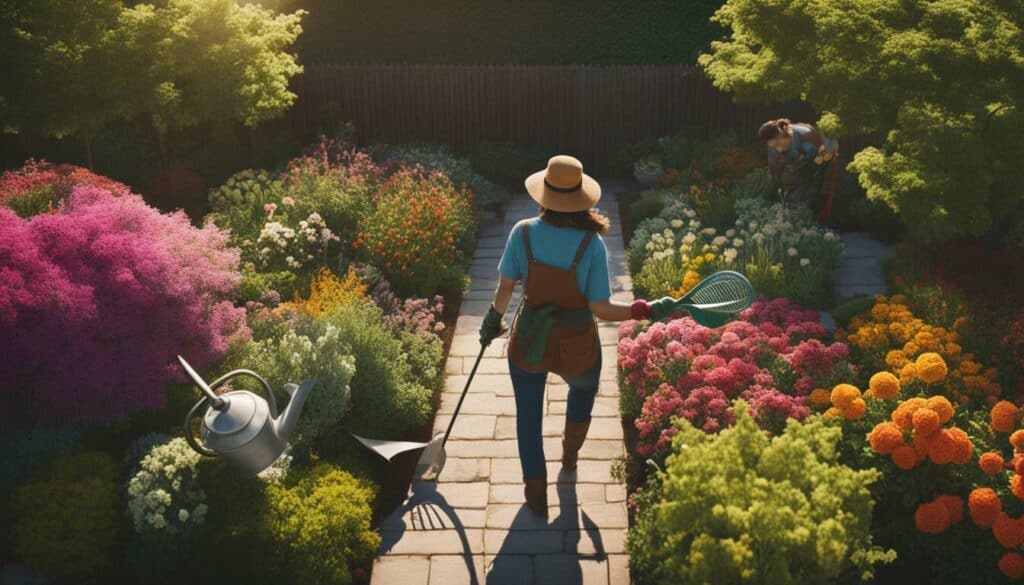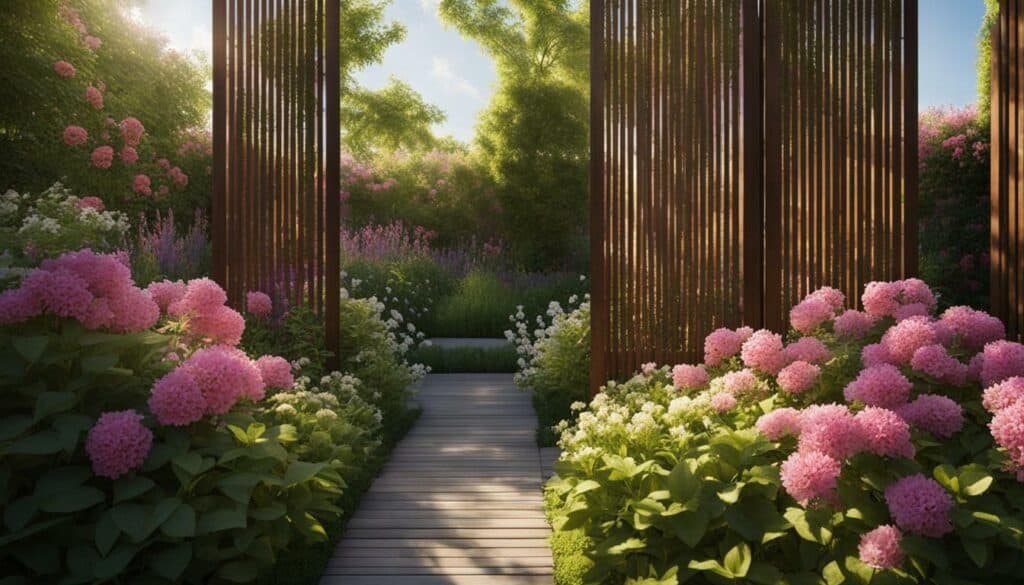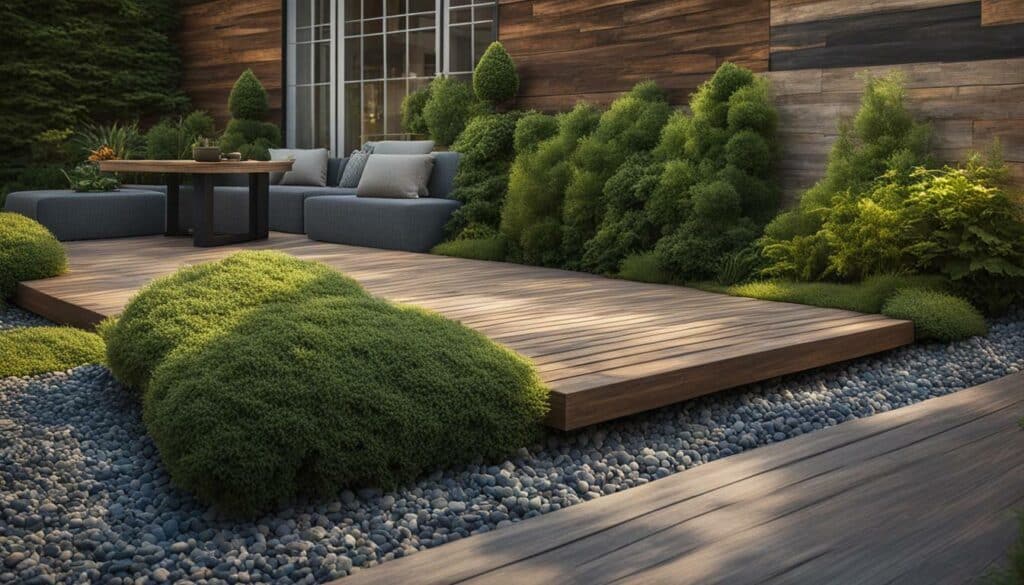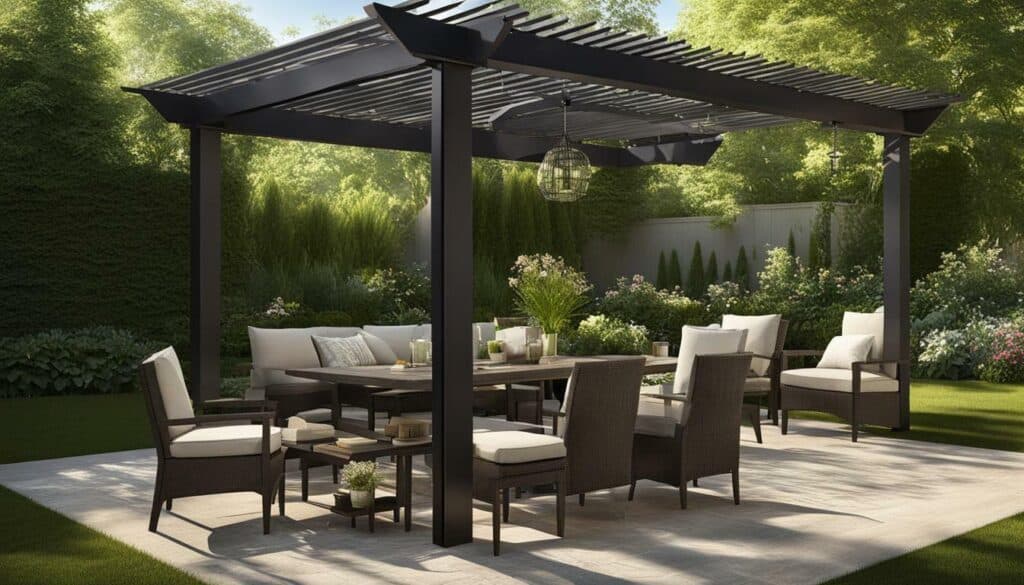Discovering the best garden setup for your outdoor haven involves considering various factors such as garden design, lawn care, planting, trees, seating areas, calming elements, privacy screens, materials, shade, and growing your own fruit. It’s essential to observe your garden’s position, direction, and outlook while planning and thinking about how you and your household want to use the space.
Transforming your garden into an outdoor haven starts with getting your lawn into shape. Proper lawn care and maintenance, such as pruning branches to prevent excessive shade, watering, and soil aeration, are necessary for a lush, verdant lawn. Planning your planting is another crucial step in creating the best garden setup. By incorporating a mix of evergreen plants and flowering plants for year-round interest and utilizing structural plants such as evergreen shrubs, you can achieve a coordinated and harmonious effect.
Key Takeaways:
- Understanding your garden’s position and direction is crucial for planting choices and the overall use of the space.
- Proper lawn care and maintenance are necessary for a lush, verdant lawn.
- Stick to using five or six different types of plants, repeated patterns for a coordinated effect.
- Incorporating drought-tolerant plants and native species can make your garden more sustainable.
- By following these guidelines and considering your specific needs and preferences, you can discover the best garden setup for your outdoor haven.
Designing Your Garden Setup
Designing your garden setup is the first step towards creating an outdoor haven that reflects your personal style and preferences. To begin, consider the purpose of your garden, the shape and layout of your space, and the specific elements you want to incorporate into your design.
When planning your garden, take into account the position, direction, and outlook of your space, as well as the amount of light and sun exposure different areas receive throughout the day. This will allow you to plan your landscaping and planting to maximize the use of natural light.
Creating a clear idea of how you want to use your garden will help guide the design process. Key aspects to consider include shaping your lawn, planning your planting to include structural plants and flowering plants, incorporating seating areas, and adding calming elements such as water features and scented plants.
It’s also important to consider screening out distractions, limiting the number of materials and colors, creating shaded areas, and even growing your own fruit. Developing a style and aesthetic for your garden using mood boards can help ensure that the final result is not only beautiful but functional and in line with your preferences.
When designing your garden setup, it’s important to take into account the maintenance requirements of the space. Opting for cost-effective solutions such as starting from seeds when planting, making your own compost, buying second-hand items, and taking on do-it-yourself projects can help to keep costs down.
Overall, by taking the time to plan and design your garden setup with these tips in mind, you can create a beautiful and functional outdoor space that suits your needs and lifestyle.

Maintaining Your Garden Setup
Maintaining your garden setup is crucial for ensuring its longevity and keeping it in its best condition throughout the year. To achieve this, you need to assess the layout and purpose of your garden, considering factors such as light, access, and your desired use of space. By doing so, you can identify areas that require the most attention and develop a maintenance plan that meets your garden’s specific needs.
One area that often requires regular care and maintenance is the lawn. Keep it in good shape by cutting branches that may cause excessive shade, watering it appropriately, and aerating the soil to prevent compaction. Additionally, be sure to fertilize the lawn periodically to keep it healthy and lush.
When planning your planting, consider incorporating structural plants such as shrubs and trees to provide a solid backbone for your garden design. Fill gaps with flowering plants and use containers and climbers to maximize space. Regular pruning and deadheading can help keep plants healthy and promote new growth.
Another way to add to the ambiance of your garden and promote relaxation is by incorporating calming elements. Water features, such as fountains or ponds, can create a soothing atmosphere, while scented plants, like lavender or jasmine, can add an aromatic touch.
Privacy is another important consideration when maintaining your garden setup. Tall screens, like bamboo or grasses, can create a natural barrier while adding texture and structure to your design. Alternatively, planting tall trees or hedges can also provide privacy and shade.
When choosing materials, keep the design simple by limiting the use of materials and colors. This will create a cohesive look and make maintenance easier. Consider adding a shaded area, like a pergola or umbrella, as a retreat from the sun.
Finally, consider growing your own fruit to add a self-sufficient touch to your garden. Choose fruit trees or bushes that are appropriate for your climate and soil conditions, and be sure to provide adequate care and maintenance to ensure a bountiful harvest.

By following these garden setup tips for maintenance, you can keep your outdoor haven looking beautiful and functional throughout the year.
Adding Greenery and Planting Tips
Adding greenery and plants to your garden setup not only enhances its visual appeal but also brings life and vibrancy to the outdoor space. When planning your garden, consider the lighting conditions and access to the space, as well as the purpose of the garden.
Start by getting your lawn in shape with proper care and maintenance, mowing it regularly and feeding it with the appropriate nutrients. If you prefer a more natural and wildlife-friendly look, consider letting your lawn grow long and wild.
When it comes to planting, consider incorporating structural plants such as small trees and shrubs to provide year-round interest and act as focal points. Fill gaps with flowering plants, and use containers and climbers to make the most of the available space.
Trees are a great addition to any garden setup, providing shade, privacy, and numerous benefits for nature. Consider planting a mix of deciduous and evergreen trees to ensure year-round interest and to create a diverse ecosystem.
Creating a moodboard can help you determine the style and aesthetic of your garden, while also taking into account its function and maintenance requirements. Draw a plan of the garden and place important features accordingly, taking into account the shape of the garden and its aspects. Opt for groups of trees or odd numbers of plants for impact, and choose a mix of evergreen and flowering plants for year-round interest.
Stick to a budget by starting from seeds, making your own compost, creating virtual moodboards, buying second-hand items, and undertaking DIY projects. These tips will help you create a stunning and sustainable outdoor space that you can enjoy for years to come.

Creating a Relaxing Atmosphere
Creating a relaxing atmosphere in your garden setup is essential for transforming it into a serene haven where you can unwind and enjoy nature. To achieve this, consider incorporating calming elements and comfortable seating areas that suit your style and preferences.
Start by designing your garden with a layout and shape that promotes relaxation, utilizing sunlight and shade to your advantage. Choose a design style that reflects your personality, whether it be modern and minimalist or rustic and cottagecore. Incorporate seating areas where you can sit back and unwind, such as a simple bench or a luxurious hammock. To enhance the peacefulness of your garden, consider adding a water feature such as a fountain or pond.
Select plants and herbs that not only add to the beauty of your garden but also emit soothing scents, such as lavender, rosemary, and thyme. Screens and tall trees can provide privacy and block out distracting noises or sights.
Limit the number of materials and colors used in your garden to maintain a clean and simple aesthetic. Create shaded areas to protect yourself from the sun and grow your own fruits and vegetables for a self-sufficient and relaxing experience. Lastly, stick to a budget by starting from seeds, making your own compost, using second-hand items, and taking on DIY projects.

By incorporating these ideas, you can create a relaxing atmosphere in your outdoor space that promotes peace and tranquility, allowing you to fully enjoy your garden as a serene sanctuary.
Ensuring Privacy in Your Garden
Privacy is an important aspect to consider when designing your garden setup, as it allows you to enjoy your outdoor space without any disturbances. There are various ways to maximize privacy and create a relaxing atmosphere in your garden.
One way to achieve privacy is to strategically place tall trees or shrubs to block unwanted views and create a more secluded atmosphere. Another suggestion is to use screens or trellises covered with climbing plants to add privacy while also adding beauty to the garden. These privacy screens can be made of different materials such as bamboo, wood or metal, depending on your preferences and budget.
Creating a quiet seating area away from prying eyes can be done with the addition of a stylish bench, hammock, or outdoor floor cushions. Adding water features and scented plants can enhance the atmosphere and create a calming environment. It is important to choose plants that suit your local climate, soil, and light conditions, and that require minimal maintenance.
Limiting the number of materials and colors used can contribute to a clean and minimalist look in the garden. Additionally, considering the aspect and shape of the garden, as well as the function and maintenance required, can help you create a space that meets your specific needs. For instance, you can use lighting to highlight the most attractive features of your garden or create different zones for various activities, such as dining, playing, or relaxing.
It is also important to stick to a budget, and there are several cost-saving strategies, such as starting plants from seeds, making your own compost, buying second-hand tools and furniture, and DIY projects. By implementing these ideas, you can ensure privacy in your garden while creating an enjoyable and comfortable outdoor space.

Choosing the Right Materials
Selecting the right materials for your garden setup is crucial to ensure its longevity and create a visually appealing outdoor space. When considering materials for your garden design, it’s important to think about the function of each area and the effect it will have on the overall aesthetic.
Take time to observe how different parts of your garden receive light and sun at different times of the day to influence your plant choices and the activities you can enjoy in your garden. Lawn, for instance, does not have to be the main focus of your garden. Consider integrating grass into other natural surfaces, like stone or wood, for a more unified look.
When it comes to planting, starting with structural plants and filling in gaps with pretty flowering plants is a good rule of thumb. By sticking to a limited number of plant types and arranging them in repeated patterns, you can create a coordinated and harmonious landscape. Containers also offer flexibility, allowing you to move plants around as needed, while climbing plants and evergreens add height and interest to the garden.
Trees, which provide shade, screen unattractive views and offer benefits to nature, can also serve as a starting point for building a garden design. Multi-stem trees have become popular in creating stunning architectural showpieces, and underplanting enhances their visual impact.
When redesigning or updating your garden, it is important to establish a budget and save money where possible. Starting from seeds, making your own compost, buying second hand, and undertaking DIY projects are all cost-effective solutions. Consider creating a mood board to agree upon the style and aesthetic you want to achieve and to plan the layout accordingly. By choosing the right materials and considering various factors, you can create a garden that meets your needs, enhances your outdoor space, and provides a sustainable and enjoyable environment for years to come.

Incorporating Shade Solutions
Incorporating shade solutions in your garden setup is essential for providing relief from the sun’s harsh rays and creating comfortable outdoor spaces. When planning your garden, it is crucial to consider the position, direction, and outlook of your garden to determine where and when shade is needed.
Shade can be achieved through various means, such as incorporating trees, pergolas, or shade sails into the design. Trees not only provide shade but also block the glare of the sun and can be used as anchors for shade sails or hanging decorations. Pergolas can create a lovely seating area and can be adorned with climbing plants for added visual appeal.
Additionally, it is beneficial to include a designated seating area in your garden where you can relax and seek shade when the sun is too intense. Other elements that can contribute to a peaceful and shaded environment include the use of water features and the strategic placement of screens to provide privacy and block out external distractions.

Limiting the number of materials and colors used in your garden design can also create a clean and simple look. Lastly, it is important to consider the functionality and maintenance of your garden when incorporating shade solutions, ensuring that the design suits your needs and lifestyle. By incorporating these shade solutions, you can create a beautiful and comfortable outdoor space to enjoy throughout the year.
Growing Your Own Fruit
Growing your own fruit in your garden setup not only allows you to enjoy fresh produce but also adds an element of self-sustainability and satisfaction. To maximize garden space, consider incorporating dwarf fruit trees or using espalier techniques to train fruit trees against walls or fences. You can also grow fruit in containers, making it easy to move them around and protect them from harsh weather conditions.
When choosing fruit to grow, consider your climate and the amount of sunlight your garden receives. Some fruit trees, such as citrus and figs, thrive in warmer climates, while others, such as apples and pears, prefer cooler temperatures. It is also important to choose disease-resistant varieties to ensure a healthy and productive harvest.
Ensure that your fruit trees are regularly pruned and trained to maintain their shape and promote healthy growth. Pruning also helps to increase fruit production and improve fruit quality. Additionally, make sure to fertilize your fruit trees with a balanced fertilizer and water them adequately.
Another great way to maximize garden space is to incorporate vertical gardening techniques, such as growing fruit on trellises or training them to grow upward on poles. This not only saves space but also adds interest and dimension to your garden design.
Overall, growing your own fruit in your garden setup is a fulfilling and sustainable way to enjoy fresh produce. With proper planning and care, you can turn your garden into a thriving fruit orchard that not only provides delicious fruit but also adds beauty and interest to your outdoor haven.

Conclusion
Creating the best garden setup for your outdoor haven involves careful planning, creative design, and attention to detail, resulting in a space that reflects your personal style and provides a haven of relaxation and beauty. It’s important to consider factors such as the shape of the lawn, the type of plants and flowers, and the overall aesthetic of the garden in order to achieve a desired outcome. Additionally, the purpose of the garden should be taken into account, whether it be for socializing, relaxation, or growing your own fruits and vegetables.
One helpful tip is to create a moodboard to visualize the style and design elements you want to incorporate. This can help you stay focused and ensure that all aspects of the garden work together harmoniously. In addition, considering maintenance requirements and budget constraints is crucial in ensuring the success of your new garden.
Whether you prefer a modern or traditional garden design, incorporating greenery, comfortable seating areas, shade solutions, and privacy screens can greatly enhance the overall experience. By following these tips and being mindful of your individual needs and preferences, you can create the garden of your dreams.
Remember, a well-designed garden not only adds beauty to your outdoor space but also enhances your lifestyle and brings joy for years to come. So, take your time, plan carefully and enjoy the process of creating the garden that best suits your needs. With these garden setup tips and design ideas, you can create a breathtaking and functional space that you’ll love spending time in.
Are Basil and Tomato Flavored Lays Chips a Good Snack Option for a Garden Setup?
Are garden basil and tomato lays chips a good snack option for a garden setup? These chips combine the flavors of fresh basil and ripe tomatoes, offering a unique taste experience. Adding a touch of nature to your snack, they make for a delightful treat while enjoying your garden.
What are the Best Home Gardening Practices for Setting Up a Beautiful Outdoor Haven?
When it comes to creating a stunning outdoor haven, implementing the right home gardening practices for lush greens is essential. Start by choosing the perfect location with adequate sunlight and check the soil for proper drainage. Optimize plant nutrition with organic fertilizers and water wisely to avoid overwatering. Regular pruning and pest management are vital for maintaining a healthy garden. Lastly, select a diverse range of plants to ensure a vibrant and visually appealing landscape.
FAQ
Q: What factors should I consider when planning my garden setup?
A: When planning your garden setup, it’s important to consider factors such as garden design, lawn care, planting, trees, seating areas, calming elements, privacy screens, materials, shade, and the ability to grow your own fruit. These factors will help create a functional and personalized outdoor haven.
Q: How can I make my garden setup easy to maintain?
A: To make your garden setup easy to maintain, you can incorporate low-maintenance plants, use mulch to suppress weeds, automate irrigation systems, and implement sustainable gardening practices such as making your own compost. These steps will help minimize the effort required to keep your garden looking its best.
Q: Are there cost-effective solutions for creating a garden setup?
A: Yes, there are several cost-effective solutions for creating a garden setup. Starting plants from seeds, making your own compost, buying second-hand garden items, and utilizing creative DIY projects can help you stay within your budget while still achieving your dream outdoor space.
Q: How can I ensure privacy in my garden setup?
A: There are various ways to ensure privacy in your garden setup. You can use privacy screens, strategically place plants or trees to create natural barriers, or incorporate tall structures such as pergolas or trellises. These options will help create a secluded and serene environment.
Q: What materials should I choose for my garden setup?
A: When choosing materials for your garden setup, consider factors such as durability, aesthetic appeal, and cost-effectiveness. For example, opting for weather-resistant materials like stone or composite decking can ensure longevity, while recycled or repurposed materials can be both eco-friendly and budget-friendly.
Q: How can I incorporate shade into my garden setup?
A: Incorporating shade into your garden setup can be achieved through various means. You can install a pergola or umbrella to provide overhead shade, choose shade-tolerant plants for certain areas, or strategically position seating areas under natural shade sources like trees. These solutions will help create a comfortable and cool space.
Q: Is it possible to grow my own fruit in a garden setup?
A: Absolutely! Growing your own fruit in a garden setup is not only rewarding but also allows you to enjoy fresh and organic produce. By maximizing garden space through vertical gardening, utilizing dwarf fruit tree varieties, and implementing proper care and maintenance techniques, you can have a fruitful harvest right in your own backyard.
Source Links
- https://laidbackgardener.blog/2021/08/24/how-to-transform-your-garden-into-a-simple-outdoor-haven/
- https://www.tiliahomes.co.uk/blog/creating-your-outdoor-haven-new-build-garden-ideas-44
- https://www.housebeautiful.com/uk/garden/designs/a495/garden-design-ideas/
- https://simplysmartgardening.com/garden-design-how-to/
- https://growinginthegarden.com/gardening-for-beginners-how-to-start-a-garden-in-8-simple-steps/
- https://www.almanac.com/over-20-vegetable-garden-layout-ideas
- https://www.countryliving.com/gardening/garden-ideas/g746/garden-plans/
- https://www.apieceofrainbow.com/vegetable-garden-layout-design-ideas/
- https://savvygardening.com/patio-vegetable-garden/
- https://www.thespruce.com/how-to-start-a-garden-from-scratch-2132778
- https://www.bhg.com/gardening/yard/garden-care/ten-steps-to-beginning-a-garden/
- https://www.gardenstone.co.uk/inspiration/create-a-place-of-sanctuary-in-your-garden/
- https://help.gardeningexpress.co.uk/knowledge-base/relaxing-garden-ideas-2/
- https://www.idealhome.co.uk/garden/garden-ideas/relaxing-garden-design-ideas-15-of-the-best-38933
- https://www.gardendesign.com/landscape-design/privacy.html
- https://harmonyinthegarden.com/2021/05/landscaping-for-privacy/
- https://www.realhomes.com/us/advice/how-to-improve-privacy-in-your-garden
- https://www.gardenary.com/blog/how-to-choose-a-raised-garden-bed-material
- https://bonnieplants.com/blogs/garden-fundamentals/choose-your-garden-type
- https://www.homesandgardens.com/advice/how-to-plan-a-garden
- https://www.bobvila.com/slideshow/10-smart-ways-to-bring-shade-to-your-outdoor-space-47776
- https://www.thespruce.com/shade-ideas-for-your-yard-4134671
- https://www.bhg.com/gardening/landscaping-projects/solving-shade/shade-garden-design-ideas/
- https://www.almanac.com/vegetable-gardening-for-beginners
- https://www.bhg.com/gardening/vegetable/vegetables/planning-your-first-vegetable-garden/
- https://www.daviddomoney.com/beginners-guide-to-growing-fruit-and-veg/
- https://growingourown.wordpress.com/6-conclusion/
- https://bonnieplants.com/blogs/garden-fundamentals/lay-vegetable-garden





Leave a Reply